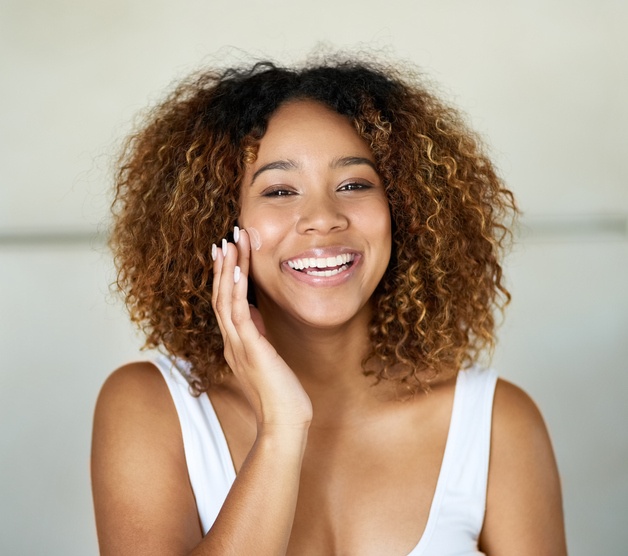As South Africans, we celebrate the richness of our diverse cultural roots, which gives us skin tones that range from very pale to deepest brown. But did you know that you need to treat your skin differently, depending on its hue?
While all human skin contains the same structures, the different amount of pigment in our skins gives us our diverse skin tones. And we have typical skin concerns that arise essentially from the amount of pigment in our skin.
Dermatologists have helpfully defined the different hues into skin types – here we’re not referring to what we generally understand as skin type – ‘normal’, oily, dry, sensitive skin. Rather, we are using the Fitzpatrick scale, which ranges from Type 1 (extremely fair) up to Type 6 (deep brown).
Why is skin tone relevant?
Those of us who fall into Skintypes 4 to 6 – with more melanin pigment in our skin – have specific skin issues (see below), while our paler sisters suffer more from sun-induced damage.
Knowing our skin tone (or type) helps us and our skin-care practitioner, because our treatment options are different and there are recommended solutions to deal with these issues, as well as treatment no-nos.
SKIN TYPES 4 – 6 (darker skin types)
Skin type six is the darkest in complexion, with a rich chocolate-brown tone. Lupita Nyongo and Naomi Campbell represent skin type six.
Skin type five complexions range from dark olive to brown and include coloured or mixed-race skin, Indian, Asian and Middle Eastern skin tones. Beyoncé and Rihanna are good representatives of this skin type.
Skin type four is olive in complexion, mostly with dark hair, as you will find in Eva Longoria and Jennifer Lopez. This is your typical ‘Mediterranean’ skin tone.
Skin challenges and treatment options of skin types 4 to 6
Pigmentation concerns
The more pigment you have in your skin, the more prone your skin will be to pigmentation problems, such as melasma (hormonally induced unevenness and dark spots), as well as dark marks after skin injury such as scarring from acne or other injuries.
Treating this can be tricky, as the causes are different and the pigmentation can be either superficial or deep-seated. This means it is essential to first identify which type of pigmentation you’re dealing with – this analysis should be performed by a trained medical or skin-care professional – before you begin treatment.
Unfortunately, pigmentation issues are chronic, requiring a long-term if not lifelong commitment. And fading existing marks without triggering new ones is finely balanced skill because skin irritation and inflammation (necessary in some treatments) can cause new pigmentation. Still, with the right tools and professional know-how, effective treatment is certainly not impossible.
The most successful pigmentation treatment results come from using combination treatments (for example, topical creams, laser, etc.), as the problem is tackled from multiple directions.
As mentioned above, people with darker skin tones often need to address acne scarring – including both scars and pigmentation – from severe acne in younger years. Recommended treatments include a combination of Carboxytherapy, Dermapen Skin Needling, Chemical Peels, Laser genesis, Fraxel Dual Laser. The Skin Renewal doctor will choose the correct combination according to your needs.
Dermatosis Papulosa Nigra (DPN)
These small brown or black freckle-like bumps, noticeable on Morgan Freeman, for example, are often mistaken for moles or warts. Completely harmless, they often occur in clusters on the face and neck and are caused by a combination of our genes, ageing and unprotected sun exposure. As we get older, they tend to increase in size and number, so people often have them removed for cosmetic reasons. Recommended treatment: long-pulsed Nd: YAG laser.
Need to know!
With darker skins in particular, it is essential to ensure that treatments are prescribed and administered by experienced professionals, especially if you’re going to have light or laser therapy, as using the wrong laser, or using the technology incorrectly, can cause skin burns and scarring.
Even though technology has evolved and lasers such as the Laser Genesis and Fraxel Dual are colour-blind, these technologies can still be dangerous if not administered correctly.
In our next feature, we tackle the challenges of skin types 1 to 3.
To schedule an individual assessment with one of the doctors on the Skin Renewal team, or to find out more about which skin-resurfacing treatments are best suited to your skin, visit Skin Renewal on www.skinrenewal.co.za or contact 0861 SKIN SA (754 672).
Take the quick Beyond Beauty Survey and you could win a R2 000 Skin Renewal voucher to spend in our online store, with free delivery within South Africa. T&Cs apply.
